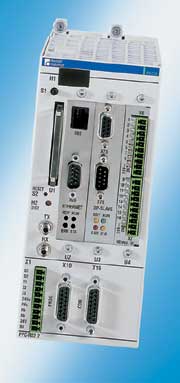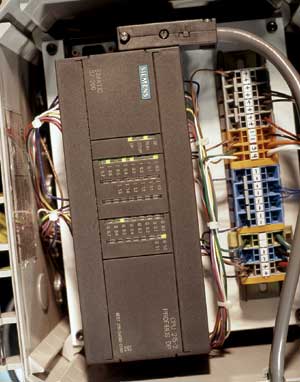
But Food Engineering found some recent applications that meet most, if not all, of these attributes. This bodes well for the food industry as improved machine control helps put better products on store shelves more quickly.

Controlling controllers
If a dairy’s cheese-making and packaging operations can be considered an integrated machine, then managing machine control and operations might look like Oregon’s Tillamook County Creamery Association’s FactorySuite System implementation from Wonderware.“We were looking for a process control-and-monitoring system that would document our process and allow us to look into that process from any point in the plant,” said James McMullen, Tillamook’s senior vice president and chief operating officer.
The system includes InTouch human-machine interfaces (HMIs) and Industrial SQL server technologies as well as InTrack inventory control. The technology system is used in the 50,000 pounds per day manufacturing process from the upfront cheese-making process through slicing, weighing, vacuum sealing, and packing, all the way to the pallets.
“The key value is the day-to-day visibility into the programmable logic controllers (PLCs),” explained Ray Norman, senior applications engineer for Wonderware’s western region. “You can see their operations and then identify and anticipate problems via HMI alarms and real-time information.”
“System interfaces host PLC connections and communicate with the manufacturing execution system (InTrack 7.0), which ties machine interfaces together up to the business-management level,” he stated. Now that Tillamook’s got 20 HMIs as part of its automation upgrade, “anywhere in the plant, you’re within 100 feet of one that gives you a bird’s-eye view of the plant. From any HMI node, you can see process and business perspectives,” said Norman.
The system has graphics that come from control-systems integrator Progessive Software Solutions, but has another useful functionality, he added: “HMIs are set up with a redundant I/O server such that, in a failure, the default is to another viewscreen.”
Because of the application’s success, the creamery installed it at its new Boardman, Oregon cheese plant, which became fully automated in the summer of 2001.

Temperature control
When Ropak Inc.’s liquid StikPak packaging machine debuted at PackExpo 2002, it contained a first-time food and beverage industry application for Phoenix Contact’s IB IL Tempcon UTH multi-channel temperature controller.With eight input/output (I/O) ports for thermocouples and output at 24 volts DC for I/O, the device was selected because “it promises to be more reliable than our previous one,” Ropak Technical Service Manager Richard Matthews revealed. “From a customer-service standpoint, the new one is easier to maintain and can be replaced more easily and cheaply.”
“It’s an adaptive proportional-integral-derivative system,” said Michael S. Nager, Phoenix Contacts’ industry mar-keting manager for the packaging industry. “To prevent product damage or ensure total sealing, we monitor two states of the packaging machine’s roller: when product is about to be sealed but rollers aren’t touching the package and when the rollers actually come over the package,” he explained.
“There are definite functionality advantages, especially in the way the temperature controller networks with other devices,” he continued, noting each liquid StikPak will use two 8-channel controllers because there are 12 control loops per machine. “We’re using DeviceNet to communicate. The previous system used two (node) addresses, but the new one uses only one.”
Tempcon, part of Phoenix Contact’s Inline I/O family, “allows you to buy slices of I/O that physically snap together on the rail,” remarked Nager, adding “it’s like a very flexible I/O card.”
That was important to Matthews: “I can add I/O—this eliminates additional addresses and hardware, he stated. The new temperature controller also “uses a lot less panel space—it’s one-third the size of the previous one—which reduces maintenance by simplifying wiring,” Matthews said.

Slicing with bricks
From bagels to bacon and turkey to pepperoni, consumers likely have purchased a product manufactured with Grote Company food slicers that are controlled with Siemens Energy and Automation’s SIMATIC S7-200 micro-PLC.These “brick” PLCs come with built-in I/O units and communication cards, unlike earlier, larger CPU-based modular controllers. There is no open rack. Everything is integrated into the solid enclosure.
“This concept greatly reduced control cabinet size for many of our designs,” said Grote Electrical Engineer Allan Hopkins. “It also enabled the automated equipment to package more product features at a lowered manufactured cost.”
“The maintenance-free device allows OEMs to design it into their equipment once and forget about it,” explained Siemens’ Product Manager Arthur Cambigue, “and permits its installation in a NEMA 4 enclosure.”
With a built-in 280 mA/24 VDC converter that supplies 24 digital inputs and a CPU216 microprocessor with 16 digital outputs, the PLC also comes standard with 16 each 0-10 VDC analog inputs/outputs.
These features are important because the device receives and processes analog information from various conveyor-line positions. The microprocessor’s built-in filtering, achieved through an averaging algorithm, stabilizes signals to make accurate readings possible, Hopkins related, adding that this functionality saved Grote from having to design a filtering scheme and purchasing an additional filter for various applications.
Several Grote-built systems interface with many digital sensors and other field devices that must communicate with the slicers’ PLCs. Something which makes some customers happy is “the device’s built-in Profibus DP connection port,” remarked Cambigue. “A second bus system that opens additional advantages is Actuator Sensor Interface or AS-I, a consortium-designed, modular bus.”
“Many Grote slicer-system brick units are custom built,” said T. Calvin Williams, senior sales engineer at Siemens, though “we have several types of applications and targeted customer groups for which repeated standardization is being sought, such as two recent bagel-slicing systems—in Greece and in Germany—for which the equipment standardized to the brick PLC.”
Accurate, smart packaging
Placing randomly spaced product in the right conveyor-belt position, upstream of the wrapping station, is the aim of Campbell-Hardage Inc.’s custom-designed, stainless-steel Accu-Loader, which uses Bosch Rexroth’s VisualMotion servo technology to control flow.“We sell to dairy, frozen-pastry, snack, and frozen-meat products producers,” said Campbell-Hardage Engineering Manager James L. Patterson. “Our product is a single machine per line: the packaging machine, intelligent-belt infeed, and three belts (in series, typically 6–8 inches wide) which, for the most part, are USDA 3A specification,” he explained. “Each belt has its own servo motor—and servos talk via a digital SERCOS fiber-optic network to a master motion controller.”
“They use our PPC controller, Ecodrive, and MKD servo motors,” said Bosch Rexroth’s North American Food and Packaging Manager, Dan Throne. “We’ve taken a powerful motion control geared around line-shafting and automated it around servo drives—a unique implementation that, without the advent of electronic line shafting and servo technology, wasn’t possible before.”
“Product must be placed with a tight tolerance,” indicated Bosch Rexroth’s Senior Applications Engineer Craig Thompson. “Their machine has two sections: accumulation and then discharge that places a product into a wrapper.
“They chose us because they needed accurate registration,” he said. “Our PPC technology handles corrections at the servo-drive level. Its photocell determines product position and then makes adjustments to properly place product on the wrapper, all up-stream of the packaging machine,” explained Thompson. “We have an encoder on the wrapper and a registration sensor to align products.”
Programming environment mattered, too. “The controller has a ladder-logic path for discrete machine control and an icon-based flowchart for high-speed motion functionality,” he said. “This is particularly well-suited for Campbell-Hardage’s product spacing and high-speed registration versus discrete functions of guard-door circuit, running external conveyors, and machine interlocks.”
Also important was ease of wiring because “with a traditional PLC-based control there were 10-15 wires per servo,” Throne explained, but “the new system saves all those wires and provides noise immunity.”
Compact. Simple. Modular. Supported. Innovative. All this plus cheaper, reliable, and easily maintained—maybe intelligent, too—are what users want from machine control. Food manufacturers should look to Gen3 machines (see sidebar on page 96) as well as open standardized systems that offer the elusive goal of interoperability and technologies that connect machine-level control and the plant through user-friendly data presentations.
Sitebar: Are you ready for Gen3?
Reinventing machinery with the advent of digital servo and the power that takes is the key issue in machine control, said Keith S. Campbell, executive director of Open Modular Architecture Control’s (OMAC’s) Packaging Machinery Workgroup.“Without this, the other two issues—the need for internationally accepted standards for integration of machines in factories, and the reduced role of PLCs—are just tech-nical curiosity,” he declared.
“Mechatronics will change machine design and definition. The new third-generation—Gen3—machines are designed from the ground up, using mechatronic principles,” stated Campbell.
“Machines need to be lighter and smaller as well as more sanitary, flexible, and modular,” he explained. “Ideally, in modular machines, instead of the central control cabinet on the floor, you’d like to have each module with its own internal controls. That way you can pull one module out and plug in another,” he added.
Shifting maintenance paradigms will require people who know design and control,” Campbell said. “You’ve got to be able to send one person out for maintenance—and it’s going to be easier to start with mechanics and teach them software than taking soft-ware engineers and teaching them maintenance,” he said.
